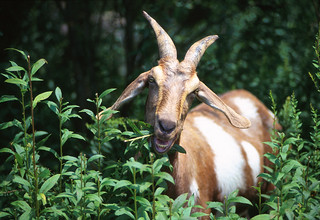Is using goats, sheep to control weeds and brush right for you?
Using goats for brush control is a business strategy with its own set of opportunities and problems. (UAPB photo)
August 22, 2014
(470 words)
PINE BLUFF, Ark. – At this time of year while livestock producers who haven’t been proactive about controlling weeds overtaking pastures are considering using goats or sheep to do so, goat producers are often thinking free feed and easy money. However, this isn’t always the case, said David Fernandez, Cooperative Extension Program livestock specialist at the University of Arkansas at Pine Bluff.
“Using sheep and goats for brush control is a business strategy and comes with its own set of opportunities and problems,” Fernandez said.
Special equipment such as a large livestock trailer, dependable truck, flatbed for equipment and fencing materials, commercial grade weed eater and brush hog to install fences, a stock tank for water, and a livestock feeder may be needed. Sheep or goat owners may have to provide shelter for animals working inside city limits.
Extra labor may also be needed. Locations where sheep and goats will be used are often steep, rocky, covered in brush and vines and difficult to traverse. Owners must be prepared to walk and work on difficult terrains. Hooking up trailers, loading and unloading equipment after a hard day of brush cutting followed by a long drive can be exhausting, Fernandez said. You may have to hire labor and provide room and meals on an extended stay.
Fences in the brush control business keep livestock in and predators out. But, as the amount of brush declines, the more sheep and goats will try to get out for feed. Most brush control businesses use a five-strand electric fence with both hot and ground wires, Fernandez said.
Some use “electronet” fencing to make it harder for predators to get through.
Liability insurance is necessary. Electric fencing, aggressive goats and guard dogs can be hazards. Insurance company attorneys can point out potential problems and advise accordingly.
Local animal welfare ordinances could be a problem as these may govern how much room each animal must have, access to shade, water and shelter, and veterinary care. Usually, these are designed for pet care and do not reflect the realities of using sheep goats to control brush, Fernandez said. .
Many producers who use goats to control brush whether all of their bucklings and keep them. Every animal a producer has eating can create income. Producers often prefer meat/dairy goat crosses because they tend to be bigger, can reach higher and knock over or penetrate brush better. Animals must be good travelers, easy to catch, and parasite and disease resistant.
The rule of thumb is that 10 goats will clean an acre in about one month. Producers need to monitor their goats and remove them before they damage trees, Fernandez warned.
Sheep and goats won’t eat everything. They will not eat wooly croton and bitter sneezeweed which could increase because of less competition from the weeds and brush eaten by goats.
A typical base fee is $1 per day per goat. Then, producers must add fees for the number of hours and distance traveled, cost of hauling (including depreciation and maintenance), cost of fencing, utility costs, veterinary costs, hotel and meals, equipment (fuel, maintenance and depreciation), livestock losses, insurance, bonds and licensing.
For more information, contact Fernandez at (870) 575-7214 or fernandezd@uapb.edu and check out Extension publication FSA 9604 “Using Goats for Brush Control as a Business Strategy.”
Pursuant to 7 CFR § 15.3, the University of Arkansas System Division of Agriculture offers all its Extension and Research programs and services (including employment) without regard to race, color, sex, national origin, religion, age, disability, marital or veteran status, genetic information, sexual preference, pregnancy or any other legally protected status, and is an equal opportunity institution.
By Carol Sanders, writer/editor
UAPB School of Agriculture, Fisheries and Human Sciences
(870) 575-7238
sandersc@uapb.edu
Related Links
